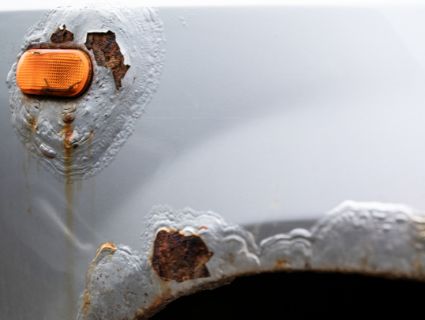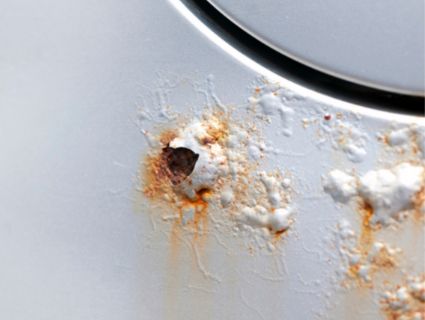The paint on your automobile bubbles for no apparent reason? What may be causing this? It is a frequently asked subject and a source of anxiety for many individuals.
When a car’s paint bubble up, it may be necessary to repaint the vehicle, even if it is a relatively recent model. It may happen for various reasons that a car’s paint could bubble up and sometimes even peel off the vehicle. Bubbles that are homogeneous across the panel are small in size: these bubbles are most likely created by moisture during the painting process. Painting a car with excessive moisture inside the airline could result in a problem.

As humidity is trapped beneath drying paint, it will eventually rise to the surface over a short period, such as a few weeks or even longer. Unfortunately, the only way to fix this would be to refinish the paneling on the wall.
Also Read: Top 5 Best Paint for Rusty Frame in 2022
Table of Contents
What Is Paint Blistering After Painting?
Blisters or bubbles form whenever a coat of paint somehow doesn’t adhere completely to the surface to which it is applied, referred to as the substrate.
When the fresh paint coat dries and pushes away from the surface, air or water bubbles beneath it, the uneven surface becomes less obvious when some of them deflate or pop on their own. At the same time, the blistering portions may never entirely reconnect to the substrate and might even subsequently begin to peel away from the surface. After any more bubbles or blisters form, they set in place and become visible when the paint is dry, leading to an inadequate surface that you’ll have to repair.
Dirt, wetness, excessive heat, and an improperly prepared surface are the most typical problems that hinder paint from adhering completely to most surfaces.
What Causes Car Paint to Bubble and Peel?

Bubbles, also called osmotic blistering, are created by paint moisture leaking through the paint’s surface. Temperatures in the neighborhood of 40 degrees Fahrenheit or humid conditions play a role. A layer of dry skin is caught between the spray and liquid. Few paint particles became stuck or damaged throughout the drying process.
You may have noticed that the paint on your automobile is peeling for various reasons. An excessive amount of UV radiation from the sun or an inadequate paint job are the most common causes of fading. For instance, if you had your automobile repainted after it was delivered from the factory and the paint had not enough dry time, the paint may peel away from the vehicle.
Typically, three levels of protection are applied to a contemporary automobile: paint, priming, and a protective clear coat. Automobile manufacturers modified the manner they applied paint in the 1980s and 1990s. It produced some issues with the primer, paint, and in certain cases, even the clear coat.
The primer, which serves as the foundation layer, protects the metal beneath it. The paint is the color coat, and it acts as a protective shell, shielding the paint from scratches and oxidation and aiding in the preservation of the paint’s shine and luster retention.
Car paint peeling, also known as de-lamination, occurs whenever one of the underneath layers of paint loses its ability to adhere to the surface. As a result, big and tiny paint flakes might come loose from the vehicle’s surface.
Scratches and dents could also cause the paint to peel away from the surface underneath them. All that is required is a minor chip in the clear coat to start the installation of delaminating the vehicle.
Therefore, you must constantly guard against theft and monitor the condition of your vehicle. As soon as the protective layer is breached, moisture and environmental toxins can infiltrate under the layers and cause more damage. The end effect is an automobile with paint flaking off, which is not appealing.
Also Read: What Happens if I Leave Car Outside in Cold Weather?
Tiny Bubbles
Small bubbles are defined as bubbles that are uniformly distributed over the whole panel. The amount of moisture during the painting process is responsible for the formation of these bubbles.
Tiny bubbles will emerge while painting a car on an airplane with too much humidity. The only way to fix this paint bubbling type is to refinish the panel completely.
Solvent Bubbles
Another sort of bubbling is known as solvent pop, and it occurs as a result of poor application of the clear layer of paint on the surface of the paint. When the clear layer is added too quickly, microscopic pinholes will appear on the paint’s surface.
Because the paint needed to escape and breathe, these pinhole-sized bubbles formed due to the top skimming or transparent coat being applied quicker than the paint had time to escape and breathe. You can repair these tiny pinhole-sized bubbles with a few simple steps. Pinhole bubbles could be removed by sanding them down and buffing them out.
De-Lamination Paint
When automobile paint delamination occurs, the car paint begins to break down as it ages, primarily due to exposure to the sun. With time, the top will start to lose its power to defend and guard the base color, eventually resulting in the base color becoming vulnerable. Initially, this ailment appears as little bubbles that eventually develop into peeling. The only way to resolve this issue is to take it down and have it refinished completely.
How To Fix Bubbling Paint on Car
To rebuild bubbled or blistered paint, you must first remove the damaged paint and prepare the surface for just a fresh coat before repainting either the entire surface or only the afflicted region. To avoid another bubbling paint job on the second attempt, you must first identify and eradicate the underlying problems.
Clean the damaged paint from the surface. Long transverse and longitudinal strokes with a putty knife can be used to gently and carefully remove the paint that has risen off the surface. If you have only a bubble or two, you don’t necessarily need to edit the entire region of the photograph.

Prepare the surface by sanding it down. Clean your putty knife and use it to fix any cracks or indentations inside the substrate with a thin coating of patching compound once it has thoroughly dried. Allow the compound to cure fully before sanding the mended portions with fine-grit sandpaper to make them smooth. Thoroughly clean the surface before applying an appropriate primer if necessary.
After the priming layer has dried, repaint the area with the appropriate brush or roller to achieve the desired effect. Stir the paint gently to avoid the production of bubbles, and then apply it with a medium-speed brush or roller. Please remember that oil-based paint can indeed be applied directly over moisture latex paint, as the two layers will not adhere as well, as bubbles or blisters will form between the two layers.
Will Paint Bubbles Go Away?
These bubbles disappear quickly, allowing the paint to dry smoothly in most cases. If you detect the bubbles popping shortly after application, they will most likely disappear on their own without leaving craters behind them. Instead, make some changes to your car paint, roller, or method to reduce bubbling.
How Much Does It Cost to Fix Paint Bubbling on A Car?
Repairing a tiny portion of bubbling paint costs $50 to several hundred dollars. However, if the bubbling is widespread, it may be necessary to repaint the entire automobile. Depending on the automobile, painting it might cost somewhere between $300 to $1,000.
How Do I Stop Paint Bubbling?

Several examples of micro-blistering have been reported when automobiles have been repaired or painted under poor conditions. Maintaining a clean and dry paint area will help to reduce the likelihood of blistering during application. It is critical to apply the proper thinner to every layer of paint during the painting process.
Combining one manufacturer’s product with some other manufacturer’s thinners also isn’t suggested, no matter how wonderful any product may be in isolation. Even worse is using a low-quality thinner, whose moisture content is frequently higher than the maximum limits allowed.
You should use enough primer and topcoat to cover the whole surface in even applications. After sanding, make sure there are several primer films left, followed by a topcoat with a matching film weight. Low film builds of any or both of these components degrades the paint structure and, therefore, can easily blister the paint. Due to the low film weight of the feather edge portion of the region, spot or localized repairs are particularly evident. Flaking is caused by various factors, the most prevalent of which are a low film weight mixed with poor climatic conditions.
Check to see that the surface to just be painted is totally clean, free of grease, and completely dry throughout the procedure. The flash-off and drying periods specified by the paint manufacturer should be rigorously adhered to. There are too many jobs that are hurried – the user may believe he is saving time, although, in the long run, the car may require further reconditioning.
FAQs
Will Painting Over Rust Stop It?
If you’ve observed that every metal object in your possession has begun to rust, it’s essential to sort out the solutions to halt the rust inside its tracks before it gets worse. You can prevent rust from expanding by painting over it. Whenever painting over rust, however, it is important to ensure that the surface is properly prepared and that the appropriate sort of paint is used.
Are You Able to Repair Rust Bubbles?
Clean the entire surface with a wax and grease remover and allow it to dry completely before continuing. Apply a coat of self-etching primer to the surface. After that, add a layer of filler primer and, once it has dried, softly sand the surface with 400 grit sandpaper to guarantee it is smooth. Finish with a fine 600 grit sandpaper to give it a smooth finish.
Is It Possible to Fix Bubbled Paint?
You can indeed repair the bubbled and blistered paint. All that is required is removing the paint, preparing the surface for a fresh coat, and repainting both the damaged regions. However, it is critical to rule out any potential reasons in hopes of avoiding a bubble problem in the near future.
What Is the Best Way to Fix Water-Damaged Paint Bubbling?
You could remove the paint from portions of the wall to prevent bubble formation, fill in the gaps with a joint compound to seal them, scratch the area with sandpaper, and wash the area beneath it.
Also Read: How Much To Fix Hail Damage On Car?
Conclusion
In the case of rust under the paint, this might be an issue if the metal was previously exposed to moisture when it was first coated. There may also be little scrapes on the paint’s surface that have caused moisture to seep below it. In the process, rust developed on the surface of the automobile’s metal. Rust is another typical issue with paint that commonly results in peeling or bubbling the paint surface. The rusted area will need to be repaired and any rust removed from the metal to prevent potential problems.
